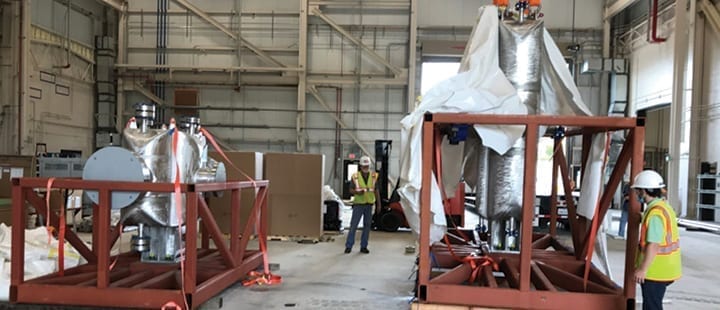Supercritical CO2 Pilot Power Plant Gearing Up for 2021 Demonstration
Construction of the 10-MW Supercritical Transformational Electric Power (STEP) pilot plant in San Antonio, Texas, is inching along, and developers in July announced that the building to house the innovative project has been completed. The pilot plant will demonstrate a fully integrated electricity-generating power system that uses supercritical carbon dioxide (sCO2) to dramatically improve size, efficiency, economics, operational flexibility, space requirements, and environmental performance of the new technology.
 |
|
5. The low-temperature recuperator and main process cooler are delivered to the building that will house the 10-MW Supercritical Transformational Electric Power (STEP) pilot plant at Southwest Research Institute’s campus in San Antonio, Texas. Courtesy: STEP Demo |
The $119 million project is spearheaded by research giant GTI in collaboration with Southwest Research Institute (SwRI) and GE Research with $84 million in funding from the U.S. Department of Energy’s National Energy Technology Laboratory. Now that construction of the 22,000-square-foot building at SwRI’s campus is complete, the developers will work to complete component manufacturing and equipment installation (Figure 5). Along with the new building, the facility will comprise a separate electronics room and a 30-ton crane to support the project operation and construction of the sCO2 power block. Other equipment constructed on the facility’s five-acre site includes external heating elements and a cooling tower. Skid-mounted components will allow for reconfiguration to accommodate future testing on other sCO2-cycle-based power systems.
Commissioning and startup are slated for early 2021, if several technical risks and challenges are overcome. “After commissioning, comprehensive testing will mitigate risks in the advancement of sCO2 technology components and demonstrate performance over a range of operating conditions, illustrating the operability and performance of this high-efficiency power cycle,” the STEP Demo coalition said on July 1.
According to GTI, by the end of the STEP Demo’s six-year project, the operability of the sCO2 power cycle will be demonstrated and documented, starting with facility commissioning as a simple closed recuperated cycle configuration initially operating at a 500C (932F) turbine inlet temperature and progressing to a recompression closed Brayton cycle technology (RCBC) configuration operating at 715C (1,319F).
The transformational technology essentially uses high-pressure CO2 instead of steam in a closed power cycle. “The unique properties of supercritical CO2 offer intrinsic benefits over steam as a working fluid in closed and semi-closed cycles to absorb thermal energy, to be compressed, and to impart momentum to a turbine,” GTI explained. The project will also uniquely attempt to advance the state-of-the-art for high-temperature sCO2 power cycle performance from proof of concept (technology readiness level [TRL] 3) to system prototype validated in an operational system (TRL 7). TRLs offer a method of estimating the maturity of technology, and range from 1 (basic principle observed) to 9 (total system used successfully in project operations). TRLs do not, however, indicate the quality of technology implemented in designs.
Advancing the sCO2 technology has involved designing and manufacturing the highly compact turbomachinery needed for the system’s aerodynamics, seals, and durability. It has so far also involved designing, scaling, and fabricating the recuperators—and ensuring they are durable. Much work is also focused on materials development to address corrosion, creep, and fatigue, as well as to ensure system integration and operability.
Among the project’s notable objectives are that it will demonstrate “the potential for producing a lower cost of electricity in relevant applications,” as well as “the potential for a thermodynamic cycle efficiency of greater than 50%.” The facility has been designed to be “reconfigurable” to accommodate for future testing, including for system and cycle upgrades, new cycle configurations, such as cascade cycles or directly fired cycles, and new or upgraded components, such as for turbomachinery, recuperators, and heat exchangers.
For now, GTI is confident that “Developing and maturing the technology at pilot scale will facilitate its commercialization and spur the development of necessary designs, materials, components, operation and control systems, sensors, and understanding and characterization needed for larger-scale sCO2 power conversion systems.”
GTI is responsible for overall management of the project, including technology management, systems engineering, major component procurements, and will participate in testing in a test management role. Along with providing the host test site, SwRI is responsible for the facility design engineering, construction of the test facility, and the supporting utility infrastructure. “As host site, SwRI will manage the hardware installation and system assembly, perform facility commissioning, and execute test operations,” the organization said. GE, meanwhile, has provided the technical definition for the turbomachinery, the turbo-expander (in collaboration with SwRI), and the compression system, as well as a first-of-a-kind sCO2 turbine stop/control valve based on its line of valves for high-pressure steam turbines.
The project is also notably being supported by a joint industry program team, which includes a steering committee to ensure a collaborative process throughout the project lifecycle. Current members include Korea Electric Power Corp. (KEPCO), Southern Co. Services, American Electric Power, and Natural Resources Canada.
GTI is separately also exploring an indirectly heated coal/biomass-based Oxy-fired Pressurized Fluidized Bed Combustor (Oxy-PFBC), and a novel high-pressure oxy-combustor for direct-fired sCO2 power cycles. “In the indirectly-heated Oxy-PFBC system, sCO2 is heated via a set of hermetically-sealed heat exchangers embedded in a footerbubbling bed of solid fuel (coal and/or biomass) particles that are combusted in a mixture of oxygen and recycled CO2 at about 8 bar,” GTI said. The resulting “compact combustor” is expected to lower the technology’s capital cost while enabling higher plant efficiencies and reducing CO2 capture costs. In the sCO2 oxy-combustor project, GTI is designing a novel high-pressure oxy-combustor for direct-fired sCO2 cycles. The design concept, which is derived from rocket engine injectors, could offer performance improvements over more traditional gas turbine-derived combustors, GTI said.
—Sonal Patel is a POWER senior associate editor.